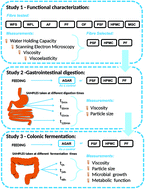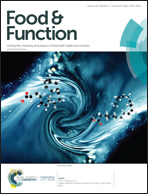Physical effects of dietary fibre on simulated luminal flow, studied by in vitro dynamic gastrointestinal digestion and fermentation
Abstract
During the transit through the gastrointestinal tract, fibre undergoes physical changes not usually included in in vitro digestion studies even though they influence nutrient diffusion and might play a role in gut microbiota growth. The aim of this study was to evaluate how physical fibre properties influence the physical properties of gastrointestinal fluids using a gastrointestinal model (stomach, small intestine, ascending colon, transverse colon, and descending colon) (simgi®). Analysis by rheological and particle size characterisation, microbiota composition and short-chain fatty acid (SCFA) determination allows the achievement of this goal. First, the water-holding capacity (WHC), microstructure, and viscosity of eight different fibres plus agar were tested. Based on the results, potato fibre, hydroxypropyl methylcellulose (HPMC), psyllium fibres, and agar (as a control) were selected for addition to a medium growth (GNMF) that was used to feed the stomach/small intestine and colon compartments in the simgi®. During gastrointestinal digestion, GNMF was collected at 5, 30 and 55 minutes of processing at the gastric stage and after the intestinal stage. Then, samples of GNMF with faecal slurry were collected at 0, 24 and 48 h of colonic fermentation. Results showed fibre-dependence on apparent viscosity. Although psyllium was partially broken down in the stomach (decrease in particle size), it was the most viscous at the colonic stage, opposite to the potato fibre, but both led to the highest total SFCA and acetic acid production profile. On a microbiological level, the most relevant increase of bacterial growth was observed in the faecal Lactobacillus species, especially for HPMC and potato fibre, that were not digested until reaching the colon. Besides fibre fermentability, viscosity also influenced microbial growth, and it is necessary to characterise these changes to understand fibre functionality.



 Please wait while we load your content...
Please wait while we load your content...